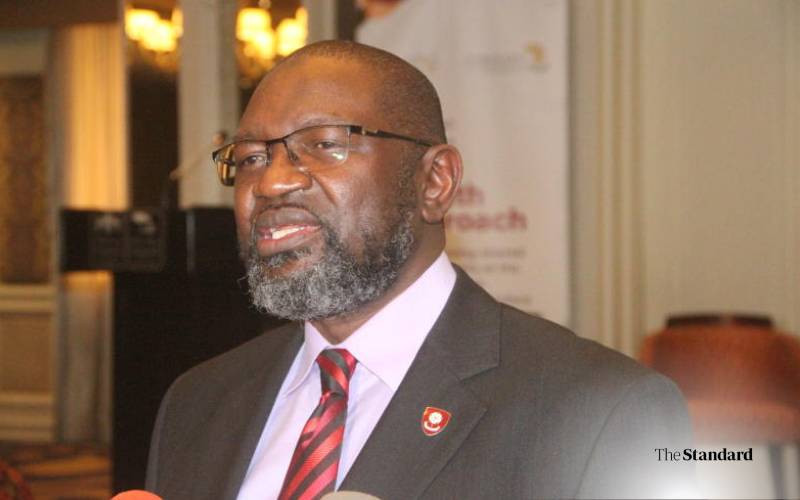Marginalised communities bear the brunt of cuts in health funding

Dr Ouma Ogwell, former acting deputy director general of Africa CDC, addressing the press at Villa Rosa Kempinski, in Nairobi. September 5, 2023. [File, Standard]
Cuts in development assistance, particularly from the U.S. government, have created significant gaps in public health systems across Kenya and the African continent.
The reduction in donor support has not only disrupted service delivery but also stalled innovation and research in the health sector.
Currently, attention is largely focused on emergency responses, such as outbreaks of M-Pox and other infectious diseases, while long-term health programs remain underfunded.
Ahmed Ogwell, former Africa CDC Director and now chief executive of Village Reach, said the reduction in funding has made it harder for marginalised and remote communities to access essential health services.
“Withdrawal of external funding means that communities previously accessing healthcare services or products are now cut off, especially in resource-poor settings. When funding stops, so does access, immediately pushing communities into the 'hard-to-reach' category,” said Dr Ogwell.
Speaking during a media engagement on global health financing on Wednesday, he emphasised that the proportion of underserved populations has grown in the past four months following the aid cuts, calling for urgent government intervention.
“The under-reached proportion has increased due to the funding gap,” he added.
Dr Bannet Ndyanabangi, Vice President of Global Programs at Village Reach, stressed the need for countries to prioritise domestic resource mobilization.
“Donor support is shrinking. Governments must increase their budgetary allocations to health. We cannot continue with inefficiencies and still expect equitable service delivery,” said Ndyanabangi.
Kenya is among the countries severely impacted by the Stop Work Order issued by U.S. President Donald Trump, which significantly disrupted HIV, malaria, and tuberculosis (TB) programs.
The country relies on the U.S. for nearly 70 per cent of its HIV programming and 30 per cent of antiretroviral (ARV) procurement.
The Stop Work Order left a funding gap of Sh30.9 billion, which was meant to support Health Products and Technologies (HPTs) and Human Resources for Health (HRH).
Despite the magnitude of the shortfall, the Kenyan government has yet to develop sustainable solutions.
Failure to address the needs of underserved populations could worsen key health indicators. For example, newborns may miss vaccinations, and maternal health outcomes could deteriorate further.
“We need to reach the most vulnerable and hard-to-reach populations consistently to guarantee quality healthcare,” said Ogwell.
The individuals are affected in terms of failure to access hospitals that were funded by the donor, availability of healthcare workers, and commodities.
“If we handle the hardest to reach, the underserved, our key indicators are going to improve better than acting at the higher level,” he said.
As a solution, he said the country, and the continent at large, should come up with innovations to guarantee the continuation of services, health developments, and the elimination of disease outbreaks.
Therefore, with limited funding, he said countries need to develop new systems, new tools, and methods to ensure all populations access quality healthcare.
“What needs to be changed is resource allocations and innovations. These two things will help amid the funding gap,” said Ogwell.
Ouma, who played a key role in leading Africa’s response to the COVID-19 pandemic, a crisis that overwhelmed health systems and claimed thousands of lives, said the pandemic taught countries, including Kenya, important lessons in resource allocation and healthcare innovation.
“It was during the pandemic that many countries began local manufacturing of medical commodities, a practice some have continued,” he said.
He recalled one of his most frustrating moments during the crisis- “I had to go to the airport to receive masks flown in from China. It was necessary for geopolitical reasons, but not for practical ones. We can make masks right here on the continent.”
He also recounted how some local companies quickly repurposed their facilities to produce masks.
“They weren’t of the highest quality, but they were widely available and helped meet urgent needs. That effort brought comfort, and some companies even advanced to manufacturing personal protective equipment (PPEs), something we can continue to improve,” said Ogwell.
Additionally, he emphasized the need for sustained innovation, a self-sufficient and resilient system.
“If the continent can scale up innovations in communication, health products, and delivery systems, we will get better returns on the investments we are making in the health sector," he said.
Innovations are not only in bigger projects, but smaller things that matter, for example, adopting mobile phones as a technology to save the lives of mothers in remote villages to avert maternal and child deaths.
For example, Village Reach adopted the use of mobile phones in Malawi to improve maternal indicators, and the use of bicycles by community health volunteers who dispense newborn vaccines and family planning services.
“When the cuts have come, what we need to do is to be innovative enough so that we do not have health indicators suffering too much,” he said.
However, even with support from donors, countries are reported not to smoothly pick up programs because of funding struggles.
As a mitigation, Ogwell observed that governments should partner with donors and partners to have them come up with realistic projects delivered at rates where the governments can be able to take them up, when the donor exits.
Despite his support for innovation, countries struggle with research for their respective innovation programs.
Most of the innovations and research, for example, were highly funded by the U.S. Government, whose support has since been stopped.
“Unfortunate thing is allocation for research in governments and resource-poor countries is very small, and the amount that goes to health research is even smaller. In Kenya, Kemri, when you do not have constant research ongoing, that was donor-funded,” said Ogwell.
He maintained that there can never be innovation without research.
“Innovation means you are testing ideas on an ongoing basis, and those ideas need to be used in a new way, but without ongoing testing of ideas, so innovation is not ready to come by,” he said.









